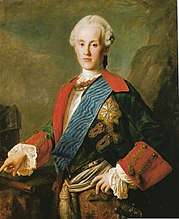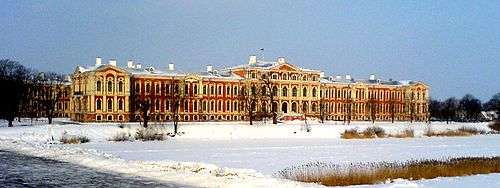Charles of Saxony, Duke of Courland
| Karl Christian Joseph | |||||
|---|---|---|---|---|---|
| Duke of Courland and Semigallia | |||||
 | |||||
| Reign | 1758–1763 | ||||
| Predecessor | Louis Ernest of Brunswick-Lüneburg | ||||
| Successor | Ernst Johann von Biron | ||||
| Born |
13 July 1733 Dresden | ||||
| Died |
16 June 1796 (aged 62) Dresden | ||||
| Burial | Marienstern Monastery, Mühlberg | ||||
| Spouse | Franciszka Corvin-Krasińska | ||||
| Issue | Maria Christina, Princess of Carignan | ||||
| |||||
| House | House of Wettin | ||||
| Father | Augustus III of Poland | ||||
| Mother | Maria Josepha of Austria | ||||
| Religion | Roman Catholicism | ||||
Prince Karl Christian Joseph of Saxony (13 July 1733 – 16 June 1796) was a German prince of the House of Wettin and a Duke of Courland and Semigallia. Born in Dresden, he was the fifth but third-surviving son of Augustus III, King of Poland and Elector of Saxony, and Maria Josepha of Austria.
Life
Causes of his election as Duke of Courland
The Duchy of Courland and Semigallia had been created in 1561 by Gotthard Kettler, last master of the Livonian Order, and had been ruled by his descendants until the dynasty died out in 1737. When that happened, Empress Anna of Russia (herself the widow of Frederick William, penultimate Duke of Courland) managed to place her lover, Ernst Johann von Biron, on the Ducal throne of Courland. Empress Anna died only three years later and was succeeded by her infant grand-nephew Ivan VI, at which time Biron was made regent of Russia. His regency lasted only three weeks. Biron was hated by the Russian aristocracy because of his extravagances and autocratic government and also for the arrogance he had shown during Empress Anna's lifetime, as her lover. The young Tsar's mother, Anna Leopoldovna and the influential minister Burkhard Christoph von Munnich conspired to remove Biron from office, confiscated his estates and exiled him to Siberia. This happened over the winter of 1740-41. Only months later, in November 1741, Russia witnessed another coup which brought Empress Elizabeth, a cousin of the late Empress Anna, to the throne. The child-Tsar Ivan VI, his mother Anna Leopoldovna and all other members of their family were arrested. Now, certainly, the new Tsarina Elisabeth gave her pardon to Biron, allowed him to return from Siberia and ordered him to take up residence in Yaroslavl. However, because of fear that he could again return to great power such as he had obtained during Empress Anna's reign, she refused to restore to him his old dignities or to the Duchy of Courland.
The matter of who would be Duke of Courland remained in stalemate for more than sixteen years. Finally, to occupy the new headship of the Duchy, the local knighthood — under pressure from Saxony and Poland — chose the favorite son of the Polish king, Prince Karl Christian, in 1758 as their new Duke. The young prince had previously travelled to St. Petersburg, from which came the agreement of Tsarina Elisabeth, confirming these plans from their part.
Duke of Courland and Semigallia
Most of Evangelic Courland aristocracy had big doubts about Karl —largely because they feared a Roman Catholic Duke would drive back his influence in favor of the Polish-Roman Catholic State— and tried to limit Karl’s means by a contract formulated electoral surrender. Before these negotiations could come to their conclusion, his father appointed him as Duke on 10 November 1758 and formally invested him on 8 January 1759 with the Duchy of Courland and Semigallia. Thereupon Karl, who had signed only a very much generally regarded assurance to religious questions and aristocratic privileges, traveled to Courland and, on 29 March 1759, he solemnly entered the capital of his duchy, Mitau. After the Courland Diet (Landtag) and the States had met, they lost their hope of wringing a statement from Karl. Nevertheless, they still favored him. Appropriately, many aristocrats refused to homage the duke’s appointment on 3 November 1759 and instead waged protest in Warsaw and St. Petersburg.

The Duke was fond of life and lived in a remarkably splendid household on the Schloss Mitau. He amused the aristocracy with parties and courtly hunts, with which he was able to increase his supporters. Also, he took over the guidance of the Freemason's medal, blossoming at that time in Poland, and protected himself so with a lot of aristocrats whom knights of an order were in agreement. He left domestic politics, however, in the hands of his Country Controller (Landhofmeister), Otto Christoph von der Howen.
Renunciation of the Duchy and later life
In July 1762, the Tsarina Catherine the Great —who had been unapproving of Duke Karl on the basis of his lacking interest in the mental education of his subjects— took the Russian throne after a coup d'état. She allowed the now entirely rehabilitated Biron to return from his exile and exercised a substantial diplomatic pressure on Saxony, with the purpose of restoring him to his old office as Duke. Finally, a sickly Augustus III —not only for his declined health but also by the consequences of the Seven Years' War— accepted the fate of his son and denied his support to him. Without any support, Karl had to renounce the Duchy in 1763, and he then returned to Saxony.
His hopes to win back the Duchy of Courland scattered after the quick death of his father and the loss of the Polish Crown for the Saxon Electors. Thereupon, Karl lived in Dresden and dedicated himself to the hunt in the Annaburger Heath.
Karl died in Dresden at age sixty-two. He was buried in the Marienstern Monastery (Kloster Marienstern) of Mühlberg.
Morganatic marriage and issue
In Warsaw on 21 March 1760, Karl secretly married Franciszka Corvin-Krasińska, daughter of Count Stanislaus Corvin-Krasiński. Because Franziska did not belong to a ruling dynasty or immediate noble family, the marriage was morganatic. In response to the persistence of Karl and the Saxon court, in June 1775 she received from Emperor Joseph II the title of Princess. The couple had two daughters:[1]
- Maria Theresia (born and died 1767).
- Maria Christina Albertina Carolina (born Dresden, 7 December 1770 - died Paris, 24 November 1851), married firstly on 24 October 1797 to Carlo Emanuele of Savoy, Prince of Carignan, and after his death she was married on 1 February 1816 to Jules Maximilien Thibaut, Prince de Montléart.
Through his surviving daughter's first marriage, Karl is an ancestor of the later Kings of Italy.
Ancestry
Notes
- ↑ Charles of Saxony, duke of Courland and Semigallia in: geneall.net [retrieved 21 September 2015].
- ↑ Genealogie ascendante jusqu'au quatrieme degre inclusivement de tous les Rois et Princes de maisons souveraines de l'Europe actuellement vivans [Genealogy up to the fourth degree inclusive of all the Kings and Princes of sovereign houses of Europe currently living] (in French). Bourdeaux: Frederic Guillaume Birnstiel. 1768. p. 100.
External links
- Heinrich Diederichs (1882), "Karl (Herzog von Kurland)", Allgemeine Deutsche Biographie (ADB) (in German), 15, Leipzig: Duncker & Humblot, pp. 297–298
| Regnal titles | ||
|---|---|---|
| Preceded by Council of the Duke |
Duke of Courland 1758–1763 |
Succeeded by Ernst Johann von Biron |